www.GemstoneBasics.com
Photomicrography > Corundum > Verneuil-grown synthetic rubies & sapphires
First draft: May 25th, 2016 | Last update: June 3rd, 2016
Diagnostic Features of Flame-Fusion-Grown (Vernueil) Rubies & Sapphires
by the technique established by Auguste V.L. Verneuil (1856-1913)
Between 1884 and 1903, rubies were offered in the gem market from an allegedly new deposit, changing hands for substantial sums. However, when they turned out to be man-made, the French Syndicate of Diamonds and Precious Stones cancelled all sales ordering stones and money to be returned to their respective owners (Nassau, 1980).
These stones were the source of inspiration for Auguste Verneuil who further paved the way to turn ruby's essential constituents into large single crystals. By 1910, he had established the process still bearing his name, the Verneuil process, which turns single oxides like aluminium oxide (Al2O3) with the appropriate dopant into ruby or sapphire. The key to growing high quality crystals is the use of high-purity base materials.
So-called boules of several hundreds of carats can be grown in a couple of hours time, but fast growth results in a considerable amount of internal strain. In order to relieve stress, the boules need to be split lengthwise prior to cutting. Albeit strongly modernised, the technique is still in use today, not only to grow corundum, but also spinel (MgAl2O4), rutile (TiO2), and strontium titanate (SrTiO3).
Sadly, telltale inclusions like curved striae and gas bubbles are often absent in pale or clean stones. Alternatively, the observation of intersecting growth structures seen parallel to the optic axis between crossed polars (Sandmeier-Plato lines or the Plato effect) are diagnostic for Verneuil. Contrarily, natural and flux-grown stones display rhombohedral polysynthetic twinning (Schmetzer, 1986).
However, the difference between Sandmeier-Plato lines (polysynthetic twinning along the prism faces) and polysynthetic twinning along rhombohedral faces can be confusing and, moreover, the Plato effect is not always observed. A far more effective method for the identification of Vernueil synthetics is the use of short wave ultraviolet (SWUV) radiation (Anderson, 1967; Elen & Fritsch, 1999; Choudhary, 2009).
Selected references and items of related interest
Anderson, B.W. (1967). Curved Striae under Short-Wave Ultra-Violet. The Journal of Gemmology, Vol. 10, No. 6, p. 199.
Anderson, B.W. (1980). Special Methods for Distinguishing Natural Corundums from Synthetics. Retail Jeweller, Vol. 19, No. 456, p. 8.
Chauhan, M. (2013).
Gem News International: Phosphorescence in Synthetic Sapphire. Gems & Gemology, Vol. 49, No. 3 (Fall), pp. 182-183.
Choudhary, G. (2009).
Synthetic sapphires with 'natural-like' sheen. Gems & Jewellery, Vol. 18, No. 3, pp. 6-9.
Also published on www.gem-passion.com
Elen, S. & Fritsch, E. (1999).
The Separation of Natural from Synthetic Colorless Sapphire. Gems & Gemology, Vol. 35, No. 1 (Spring), pp. 30-41.
Elwell, D. (1979).
Man-Made Gemstones. Ellis Horwood Ltd., West Sussex, U.K., 191 p., ISBN 0-85312-128-1 (Ellis Horwood) | ISBN 0-470-26606-6 (Halsted Press).
Eppler, W.F. (1964).
Polysynthetic Twinning in Synthetic Corundum. Gems & Gemology, Vol. 11, No. 6 (Summer), pp. 169-173.
Eppler, W.F. (1984).
Praktische Gemmologie. 2nd edition. Rühle-Diebener Verlag, Stuttgart, Germany, 504 p. (in German)
Free, J., Free, I., Brown, G. & Linton, T. (1999).
Verneuil Synthetic Corundums with Induced "Fingerprints". The Australian Gemmologist, Vol. 20, No. 8, pp. 342-347.
Kammerling, R.C. & Koivula, J.I. (1990).
Tips on Identifying Flame-fusion Synthetics. The Scope, Vol. 5, No. 2.
Koivula, J.I. (1986).
Natural vs. Synthetic Ruby Separations. Guilds: 52 Annual Conclave Issue, pp. 37-38.
Liddicoat, R.T. (1993).
Handbook of Gem Identification. 12th edition, 4th printing.
Gemological Institute of America, Santa Monica, California, 364 p., ISBN 0-87311-021-8.
Nassau, K. (1980).
Gems Made by Man. Gemological Institute of America, Santa Monica, California, USA, 364 p., ISBN 0-8733-016-1.
Nassau, K. (1990).
Synthetic Gem Materials in the 1980s. Gems & Gemology, Vol. 26, No. 1 (Spring), pp. 50-63.
O'Donoghue, M. (1983).
Identifying Man-made Gems. N.A.G. Press, London, U.K., 223 p., ISBN 7189-0111-7.
Plato, W. (1952).
Oriented Lines in Synthetic Corundum.
Gems & Gemology, Vol. 7, No. 7 (Fall), pp. 223-224.
Read, P.G. (1999).
Gemmology. 2nd Ed., Reprinted 2003. Butterworth-Heinemann, 326 p., ISBN 0-7506-4411-7.
Schmetzer, K. (1986).
Production Techniques of Commercially Available Gem Rubies. The Australian Gemmologist, Vol. 16, No. 3, pp. 95-100.
Schmetzer, K. (1986).
Natürliche und synthetische Rubine: Eigenschaften und Bestimmung.
E. Schweizerbart'sche Verlagsbuchhandlung, Stuttgart, Germany, 131 p. ISBN 3-510-65125-1 (in German).
Split Verneuil boule, sawn slab, and finished stone Besides ruby and blue sapphire, other colours can be grown as well such
as the colour changing sapphire boule on the far right especially grown to mimick alexandrite Curved striae are most conspicuous in blue flame fusion grown synthetic sapphire Different colour saturations are the result of rapid growth of the boules Windowed and polished boule of blue sapphire with thick and turbid striae Split and polished boule of pink sapphire with clearly visible striae But also minute gas bubbles emphasise curved striae contours in Verneuil-grown synthetics They run in strings more or less perpendicular to the curved striae... ... and some of these strings are so long that they appear like comet-tails Although these surface features may be less diagnostic they are a strong indication... ... as they are quite often observed on Verneuil-grown synthetics Clear stones showing no diagnostic features may be examined by means of a
polariscope in order to locate their optic axis and
interference figure that is further visualised with a
conoscope. From here on the stones are best placed under
immersion which enables viewing these hard to
find growth lines intersecting under 60°/120°. They can only be found when looking parallel to the optic axis. Polysynthetic twinning along the optic axis only occurs in Verneuil-grown material. Polysynthetic twins in natural and flux-grown corundums
run parallel to the rhombohedral faces and these stones are further characterised by the presence of natural inclusions or flux. The effect was
first noticed by E.G. Sandmeier in 1922 while the method was devised by Prof. Dr. W. Plato (1952), hence the different designations. Patchy interference colours, aka Sandmeier-Plato lines, are due to twinning seen in the optic axis Twin plane observed under a small oblique angle from the optic axis Plato effect in a longtitudinal section of a 90° Verneuil-grown boule.
Here the optic axis lies perpendicular to the growth axis. In polished material this makes no difference. For comparison and to show you the sometimes daunting similarity, polysynthetic twinning in natural rubies is shown here. The bottom line
for positive identification is that polysynthetic twinning parallel to the optic axis is only observed in Verneuil-grown synthetics
and not in natural or flux-grown stones; the latter usually containing sufficient features attesting for the stones' respective provenances. For comparison, polysynthetic (rhombohedral) twinning in a 1.25ct natural (magmatic) ruby Surface reaching (a bit hard to see) twin planes observed in magmatic rubyPhotomicrographs
Verneuil-grown boules
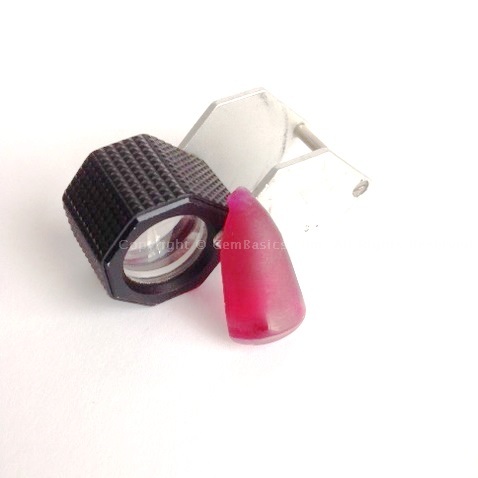
Triplet loupe shown for size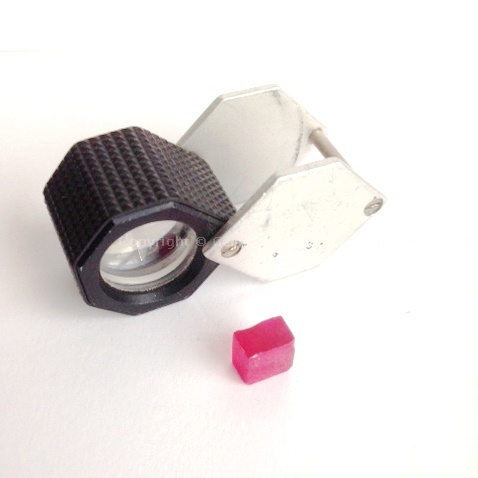
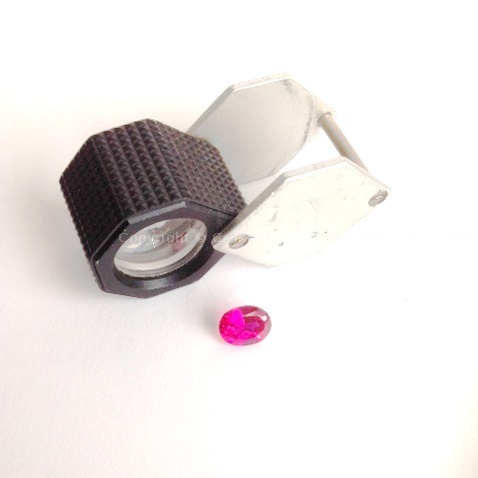
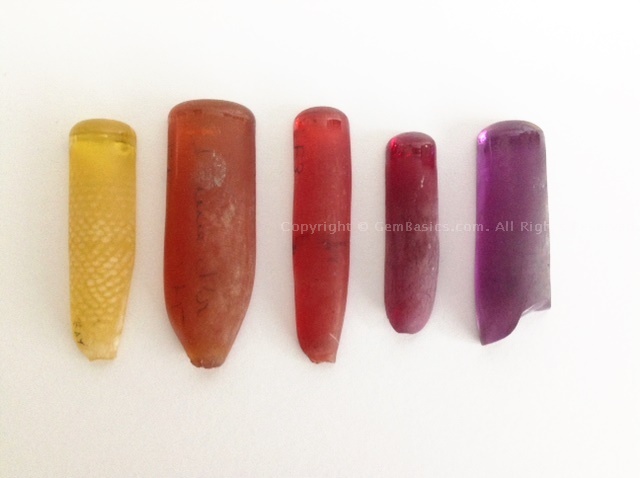
Diagnostic features in Verneuil-grown corundum
 LoRes.jpg)
18x (FoV ± 5mm) Obl, DF, X-Pol LoRes.jpg)
40x (FoV ± 3mm) Obl, DF, X-Pol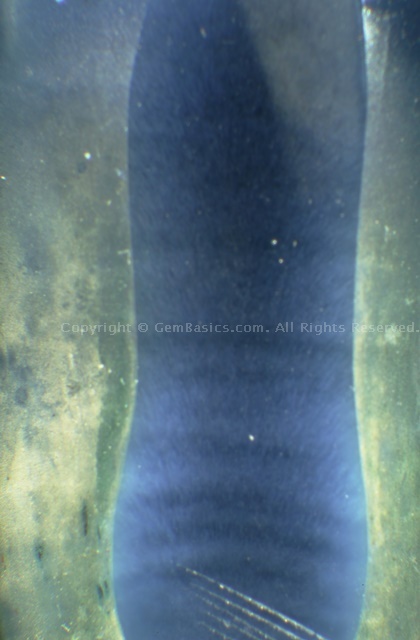
6x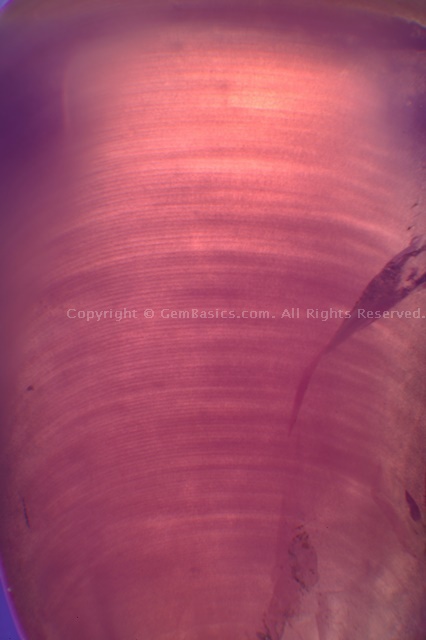
6x LoRes.jpg)
25x (FoV ± 3mm) Obl, DF, X-Pol 2 LoRes.jpg)
25x (FoV ± 3mm) Obl, DF, X-Pol LoRes.jpg)
15x (FoV ± 5mm) Obl, Pol LoRes.jpg)
40x (FoV ± 3mm) Obl, Pol LoRes.jpg)
50x (FoV ± 2mm) Obl, PolPlato effect / Sandmeier-Plato lines in Verneuil-grown synthetic corundum
 v3 LoRes.jpg)
6x (FoV ± 10mm) X-Pol LoRes.jpg)
18x (FoV ± 3mm) X-Pol LoRes.jpg)
6x (FoV ± 12mm) X-PolPolysynthetic twinning in some natural corundums
 LoRes.jpg)
18x (FoV ± 4mm) X-Pol LoRes.jpg)
18x (FoV ± 3mm) X-Pol

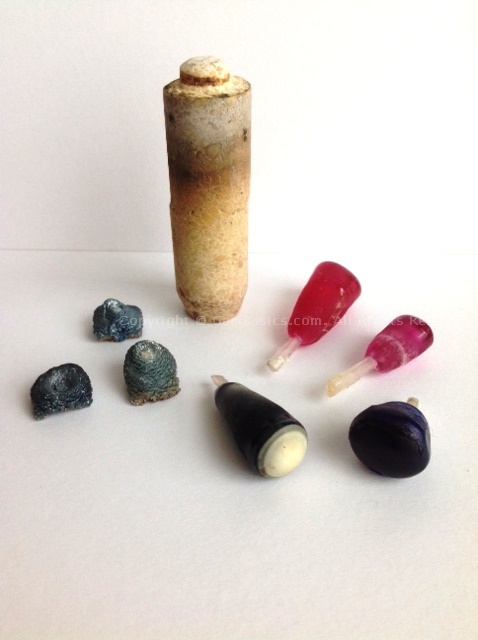
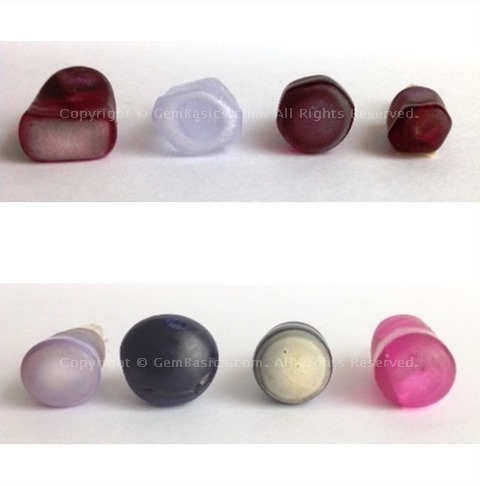
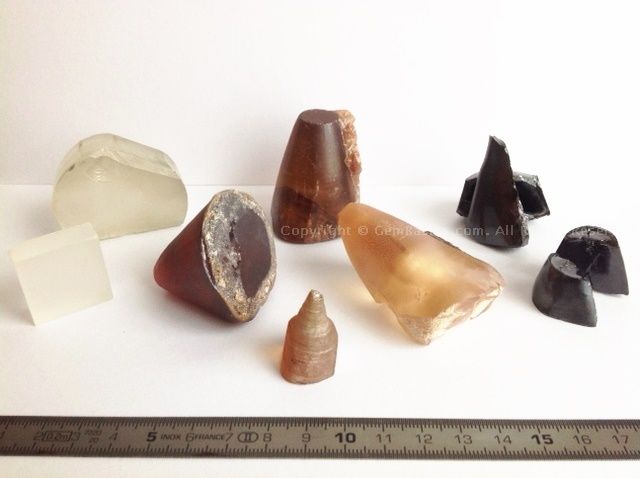
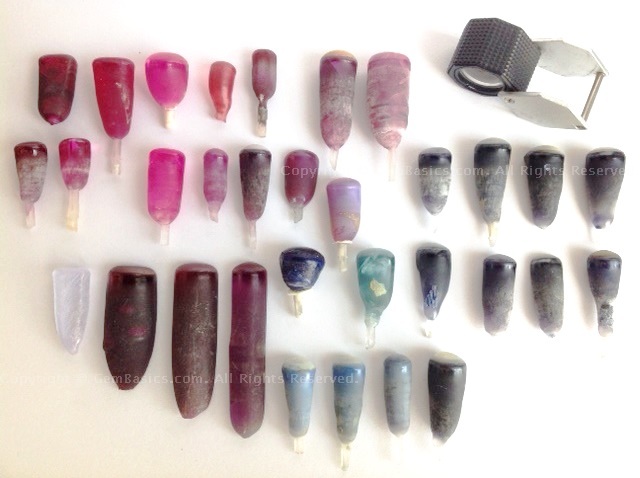
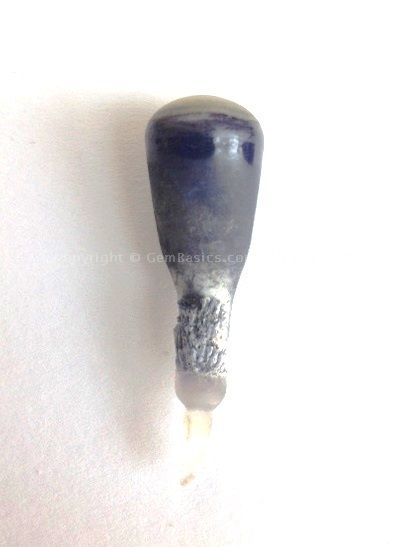
 LoRes.jpg)